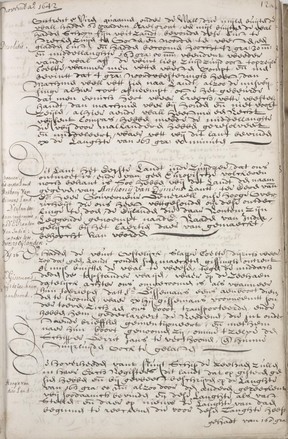Extract Uittet Journael vanden Scpr Commandr Abel Janssen Tasman, bij hem selffs int ontdecken van't onbekende Zuijdlandt gehouden
1642–43,
compiled 1643–47
Ink on laid paper bound in vellum
Safe 1 / 72
Known as the Huijdecoper journal, this
Dutch manuscript is a copy of part of Abel Janszoon Tasman’s original journal
(1642–43). The original no longer exists.
On his voyage to chart the unknown south
land, Tasman sighted the west coast of Tasmania, north of Macquarie Harbour on
24 November 1642. The next evening he made this observation:
… This land the First Land in the South sea that
we have encountered and not yet known to any European nation, so have we given
this Land the name of Anthony van Dymens Land, in honour of the Hon. Governor General
our high Superior, who has sent us out to make this discovery. The Islands
circumjacent we have named after the Hon Councillors of India, as may be seen
from the little chart made of them.
Van Diemen’s Land was renamed Tasmania in 1855.
Tasman commanded
two ships, the Heemskerk and Zeehaen.
As part of the
1642–43 voyage of discovery, Tasman circumnavigated an island continent
(Australia) without sighting land, but established that it was separated from
the hypothetical southern continent.
Following
Tasman’s voyage the Dutch started to name the island continent ‘Nova Hollandia’
(New Holland) as opposed to the unknown southern land ‘Terra Australis
incognita’.
Following Tasman’s circumnavigation, Australia was
known as ‘New Holland’ until the British colonised Australia and declared the
eastern half of the continent ‘New South Wales’.
Despite all his
achievements, Tasman’s superiors deemed his voyages as failures because he
didn’t establish trading posts.
It is interesting to note that Abel Janszoon Tasman’s
birth and death dates (b. 1603?–d. 1659–1661) are estimations, which is
surprising as he was the greatest of the Dutch navigators and explorers.
The Dutch voyage of discovery led by Abel Janszoon Tasman
is credited with being the first European expedition to encounter Tasmania, New
Zealand and Fiji.
Despite giving
the continent its name, neither the Netherlands nor the Dutch East India
Company claimed any territory in Australia as its own or attempted to
permanently settle the land.
By 1642 Dutch navigators had discovered discontinuous
stretches of the western coast of Australia, but whether these coasts were
continental and connected with the hypothetical southern continent of the
Pacific remained unknown. Tasman was assigned to solve this problem … (Helen
Margaret Wallis, Britannica Online Encyclopedia).



 Back to list
Back to list